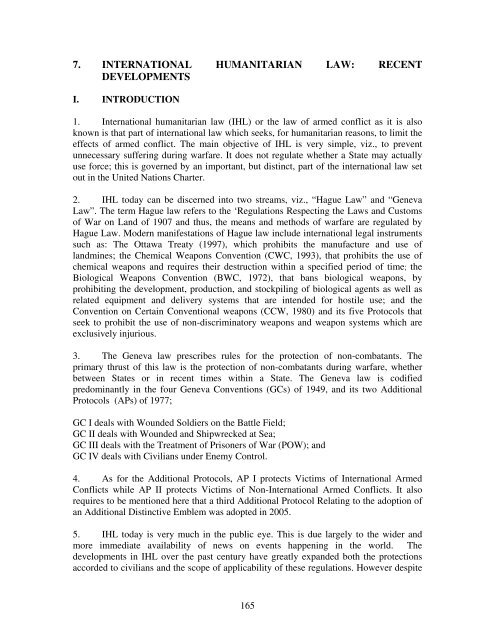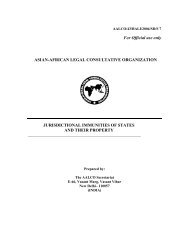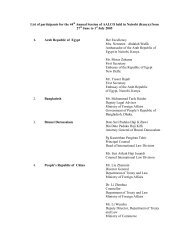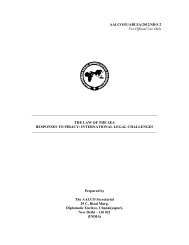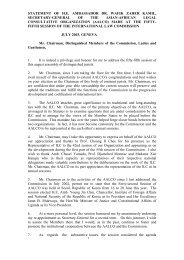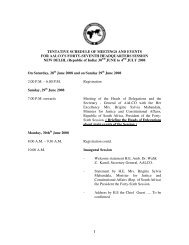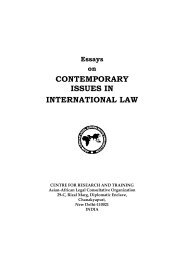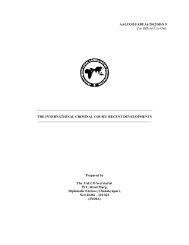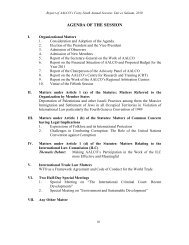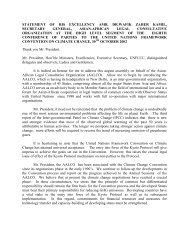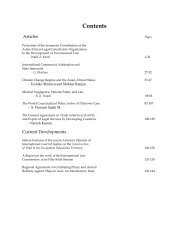7. international humanitarian law - Asian-African Legal Consultative ...
7. international humanitarian law - Asian-African Legal Consultative ...
7. international humanitarian law - Asian-African Legal Consultative ...
You also want an ePaper? Increase the reach of your titles
YUMPU automatically turns print PDFs into web optimized ePapers that Google loves.
<strong>7.</strong> INTERNATIONAL HUMANITARIAN LAW: RECENTDEVELOPMENTSI. INTRODUCTION1. International <strong>humanitarian</strong> <strong>law</strong> (IHL) or the <strong>law</strong> of armed conflict as it is alsoknown is that part of <strong>international</strong> <strong>law</strong> which seeks, for <strong>humanitarian</strong> reasons, to limit theeffects of armed conflict. The main objective of IHL is very simple, viz., to preventunnecessary suffering during warfare. It does not regulate whether a State may actuallyuse force; this is governed by an important, but distinct, part of the <strong>international</strong> <strong>law</strong> setout in the United Nations Charter.2. IHL today can be discerned into two streams, viz., “Hague Law” and “GenevaLaw”. The term Hague <strong>law</strong> refers to the ‘Regulations Respecting the Laws and Customsof War on Land of 1907 and thus, the means and methods of warfare are regulated byHague Law. Modern manifestations of Hague <strong>law</strong> include <strong>international</strong> legal instrumentssuch as: The Ottawa Treaty (1997), which prohibits the manufacture and use oflandmines; the Chemical Weapons Convention (CWC, 1993), that prohibits the use ofchemical weapons and requires their destruction within a specified period of time; theBiological Weapons Convention (BWC, 1972), that bans biological weapons, byprohibiting the development, production, and stockpiling of biological agents as well asrelated equipment and delivery systems that are intended for hostile use; and theConvention on Certain Conventional weapons (CCW, 1980) and its five Protocols thatseek to prohibit the use of non-discriminatory weapons and weapon systems which areexclusively injurious.3. The Geneva <strong>law</strong> prescribes rules for the protection of non-combatants. Theprimary thrust of this <strong>law</strong> is the protection of non-combatants during warfare, whetherbetween States or in recent times within a State. The Geneva <strong>law</strong> is codifiedpredominantly in the four Geneva Conventions (GCs) of 1949, and its two AdditionalProtocols (APs) of 1977;GC I deals with Wounded Soldiers on the Battle Field;GC II deals with Wounded and Shipwrecked at Sea;GC III deals with the Treatment of Prisoners of War (POW); andGC IV deals with Civilians under Enemy Control.4. As for the Additional Protocols, AP I protects Victims of International ArmedConflicts while AP II protects Victims of Non-International Armed Conflicts. It alsorequires to be mentioned here that a third Additional Protocol Relating to the adoption ofan Additional Distinctive Emblem was adopted in 2005.5. IHL today is very much in the public eye. This is due largely to the wider andmore immediate availability of news on events happening in the world. Thedevelopments in IHL over the past century have greatly expanded both the protectionsaccorded to civilians and the scope of applicability of these regulations. However despite165
all of these, the constantly changing landscape of armed conflict and the pursuit of justiceagainst human rights violations call for critical measures to be considered in the light ofall the actors involved. The most notable areas which pose considerable challenges toIHL include: the emergence of transnational armed groups, the trend towardsprivatization of traditional military activities, the existence of many failed States and thebanning of certain specific categories of weapons from the arsenal of many States.6. In the light of these continuing developments in IHL, AALCO Secretariat finds itimportant to prepare a Report on these developments for the reference of its MemberStates. Hence a brief note on the recent developments in IHL is being included as part ofthe Notes and Comments on Selected Items before the UNGA. This brief note focuses onthe following items:II. AALCO’s activities in the context of IHLIII. The Ottawa TreatyIV. The Convention on Cluster Munitions – Coming of Age?V. Private Military ForcesVI. General Comments.II.AALCO’s ACTIVITIES IN THE CONTEXT OF IHL<strong>7.</strong> The activities of AALCO on the issues of IHL commenced in 1997 when it hadorganized a Special Meeting in conjunction with the International Committee of the RedCross (ICRC) on the eve of Thirty-Sixth Annual Session in Tehran on an important item:“Interrelated Aspects of International Criminal Court and International HumanitarianLaw”. Ever since, both the Organizations have convened a number ofMeetings/Seminars/Conferences together. This relationship was institutionalized by aCooperation Agreement that was signed in Geneva on 7 th July 2003. Needless to say,promotion, development and dissemination of IHL is the primary objective of theCooperation Agreement.8. It is pertinent to note here that, in conjunction with its Forty-Seventh AnnualSession held in New Delhi (HQ) on 2nd July 2008, AALCO had organized a One DaySpecial Meeting on “Contemporary Issues in International Humanitarian Law” incollaboration with ICRC. In this meeting a number of current issues of IHL werediscussed and debated with the help of a group of experts. These included: the <strong>Legal</strong>Regime Governing the Use of Cluster Munitions and the entire gamut of issues governingthe efforts to conclude a treaty for banning them ( the Oslo Process and the CCWprocess); the adoption of the Landmine Ban Convention and its effective implementationover the years (the Ottawa process); and the critical issues governing the activities andfunctions of Private Military Companies, with a special emphasize on their legal status.The deliberations that took place during that meeting were of very informative as well aspractical utility that the Member States of AALCO appreciated immensely.166
III.THE OTTAWA TREATY9. Landmines are powerful and unforgiving devices. Unlike other weapons of war,most of which must be aimed and fired, anti-personnel landmines are victim actuated.That is, they are designed to be detonated by a person stepping on or handling the deviceor by disturbing a tripwire attached to it. Once emplaced, anti-personnel landmines areindiscriminate in their effects and unless removed or detonated, long lasting. In additionto the devastating impact on individual lives, mines also have severe social and economicconsequences, particularly for a country attempting to rebuild after the end of armedconflict.10. The failure of efforts within existing structures of <strong>international</strong> cooperation and<strong>law</strong> (such as via, Protocol to the CCW, 1980) to address the landmine issue promptedmany ban supporters to seek alternative means to address the issue. This gave birth to the‘Ottawa Process’ which was the Canadian-sponsored strategy Conference towards aglobal ban on Anti-Personnel Land Mines in 1996, with the active support of 50Countries, the ICRC, the International Campaign to Ban Landmines (ICBL) and the UN.11. In 1997, the Convention on the Prohibition of the Use, Stockpiling, Productionand Transfer of Anti-Personnel Mines and On Their Destruction (the Ottawa Convention)was adopted and opened for signature. This represented the successful culmination of theOttawa Process. The importance of this treaty could be understood from the words of theformer UN Secretary-General Mr. Kofi Annan who hailed this treaty as “a historicvictory for the weak and vulnerable of our world”. As of now the number of StatesParties to the Ottawa treaty stands at 156 1 .A. Salient features of the Ottawa Convention:12. The scope of the treaty is very clear and the general obligations that are outlinedin Article 1 are unambiguous;.Each State Party undertakes never under any circumstances:a. to use anti-personnel mines;b. to develop, produce, otherwise acquire, stockpile, retain or transfer to anyone;directly or indirectly anti-personnel landmines;c. to assist, encourage or induce in any way, anyone to engage in any activityprohibited to a State Party under this Convention [Article 1, Para. 1]1 The following 26 AALCO Member States are party to the Ottawa treaty: Bangladesh, Botswana, BruneiDarussalam, Cameroon, Cyprus, Gambia, Ghana, Indonesia, Iraq, Japan, Jordan, Kenya, Kuwait,Malaysia, Mauritius, Nigeria, Qatar, Senegal, Sierra Leone, South Africa, Sudan, Tanzania,Thailand, Turkey, Uganda and Yemen.167
13. The final component of the comprehensive ban established by the Ottawa Treatyis a prohibition on transferring anti-personnel mines. A country is not allowed in any wayor under any circumstances to transfer anti-personnel mines either directly or indirectly.The Prohibition on transfer covers import and export as well as transfer of ownership ofmines. There is however some exceptions provided: firstly, Countries are permitted totransfer anti-personnel mines for the purpose of destruction. Secondly, they may transferthe limited number of mines allowed to be retained for training purposes.14. The Ottawa Treaty obliges each State Party to clear all anti-personnel minesalready in the ground within a period of 10 years following its entry into force for thatCountry. In particular, the State must destroy all anti-personnel mines in ‘mined areas’under its jurisdiction or control.15. The Ottawa treaty calls upon all countries able to help to do their utmost to ensurethe care, rehabilitation and reintegration of mine victims. A specific role for ICRC hasbeen given in this regard, on the rehabilitation and reintegration of mine victims.16. The Ottawa treaty provides for a number of procedures and mechanisms topromote its implementation; at the heart of the treaty’s verification system is self -reporting by States Parties. Article 7 on “Transparency Measures” requires States Partiesto submit reports detailing their compliance under nine categories:(i) national implementation measures (legal and administrative);(ii) the number and types of stockpiles;(iii) the location of mined areas;(iv) the numbers and types of mines retained for training purposes;(v) the status of conversion and decommissioning programmes for productionfacilities;(vi) the methods, location and status of mine destruction programmes;(vii) the number and types of mines destroyed;(viii) the technical characteristics of mines formerly produced; and(ix) measure to warn the public about mined areas.1<strong>7.</strong> Reports under Article 7 are submitted to the UN Secretary-General, the depositaryfor the Convention. The State Parties must submit an initial, baseline report as soon aspossible and in any case not later than 180 days after the treaty enters into force for them.The treaty requires the UN Secretary-General to transmit those reports to all the Parties.18. While there are no procedures in the treaty for determining the veracity of ‘Article7 Reports’, there are mechanisms for verifying suspected cases of non-compliance. If aState Party is suspected of violating any treaty prohibition, the treaty allows for any otherState Party (‘requesting State’) to submit a ‘Request for Clarification’ to the suspectedState (‘requested State’) through the UN Secretary-General. The latter has to respondwithin 28 days. If a response is not received or is deemed unsatisfactory by the former, itmay submit the matter to the next Meeting of State Parties [MSP]. The MSP may thenauthorize and mandate an ‘on-site Fact-Finding Mission’ in the requested State to collect168
additional information for use in determining compliance [Article 8 (8)]. It is alsoimportant to remember the fact that no reservations are possible to any of the treaty’sprovisions [Article 19].19. While empirical data on the effects of the Ottawa Convention has been difficult toacquire, the Landmine Monitor report 2 suggests widespread compliance with treatymandates with regard to transparency, production, transfer, stockpile and use.Firstly, the overwhelming majority of State Parties have complied with initialtransparency requirements. This early compliance is critical as it makes ongoingverification of treaty compliance easier by providing clear baselines of comparison.Secondly, landmine production has been significantly reduced. More than 40 Countrieshave completely eliminated the production of anti-personnel landmines.Thirdly, landmine exports have been almost eliminated entirely. Since the adoption of thetreaty, there have not been any verified shipments of landmines between countries. Evenmany Non-Signatory States have official export moratoriums or bans in place.20. These positive developments were echoed aptly by the UN Secretary-GeneralMr. Ban Ki-Moon who, on the eve of the 10 th Anniversary of the opening for signature ofthe Ottawa Treaty had opined thus:“The road to a mine-free world is long, but an end is in sight”.IV.CLUSTER MUNITIONS21. Cluster munitions are large weapons that contain dozens or hundreds of smallersub munitions. They cause unacceptable <strong>humanitarian</strong> harm in two ways: First, theirbroad- area effect kills and injures civilians indiscriminately during strikes. Second, manysub-munitions that do not explode become de facto landmines that cause civiliancausalities for months or years to come.22. Efforts toward the adoption of a comprehensive legal regime governing the use ofcluster munitions in all its manifestations have taken place in 2 multilateral fora: one isthe UN Convention on Certain Conventional Weapons (CCW) of 1980 and the other iscommonly referred to as the ‘Oslo Process’.23. The States that are Parties to the CCW, which is concerned with weapons ‘whichmay be deemed to be excessively injurious or to have indiscriminate effects, have forseveral years been examining the adequacy of existing IHL, as well as possiblepreventive measures aimed at improving the design of certain munitions including clustermunitions, with a view to minimizing the <strong>humanitarian</strong> risks of these munitionsbecoming explosive remnants of war.2 International Campaign to Ban Land Mines, “Land Mine Monitor Report 2002: Introduction”, availableat http:www.icbl.org/lm/2002/intro.169
24. Though Protocol V to the CCW on Explosive Remnants of War (ERW) whichentered into force in 2006, was a positive development in this context, it failed to come toa consensus on persuading CCW States to take the additional step of regulating clustersub-munitions use. In November 2006, at the Annual meeting of State Parties to theCCW, efforts by a small group of States to secure a mandate on negotiating a clustermunitions treaty failed.25. This failure gave birth to the Oslo Process that was initiated by Norway in 2007with the long-term view of concluding a new <strong>international</strong> treaty to prohibit clustermunitions.26. The Oslo Process group comprising of a large number of States, Non-Governmental Organizations and other groups has held five meetings to date- in Oslo,Lima, Vienna, Wellington and Dublin with increasing number of governmentsparticipating. The final text of the new Convention on Cluster Munitions [CCM] wasadopted at the final plenary meeting of the Dublin Conference on 30 th May 2008. Asignature ceremony open for all States wanting to become State Parties to the newConvention, would take place in Oslo on 2 nd December 2008. It is to be rememberedhere that the Oslo initiative on cluster munitions follows the foot steps of the OttawaProcess that successfully culminated in the adoption of the Ottawa treaty banninglandmines.A. Salient features of the Convention2<strong>7.</strong> The CCM represents a comprehensive ban on all cluster munitions in allcircumstances; the production, stockpiling, use and transfer of all cluster munitions areprohibited in all circumstances including in <strong>international</strong> conflicts and conflict of a non<strong>international</strong>nature [Article 1].28. As regards stockpile destruction, the CCM has set an eight-year deadline toeliminate stockpile of cluster arms under their jurisdiction after it enters into force for aState Party [Article 3].29. As regards clearance of contaminated areas, State Parties are obliged to clearareas contaminated by cluster munitions as soon as possible but no later than 10 yearsafter entry into force of the Convention for that State Party [Article 4].30. In addition to the prohibitions on cluster munitions, CCM also includes verystrong provisions on Victim Assistance requiring States to provide assistance to thevictims including medical care, rehabilitation and psychological support as well as totheir families [Article 5].31. All State Parties have been given the right to seek and receive assistance incomplying with the obligations arising out of the CCM [Article 6 (1)].170
32. The CCM also provides for a ‘Reporting Mechanism’ according to which eachState Party shall report to the UN Secretary-General on an annual basis , not later than180 days after the entry into force of the Convention for that State, the efforts it has takento implement the CCW [Article 7].33. As regards national implementation measures, State Parties are obliged to take allappropriate legal, administrative and other measures to implement the CCM includingpenal sanctions [Article 9].34. The CCM also provides for Meeting of State Parties [MSP] and ReviewConferences to be held. A first MSP must be held within one year of entry into force.[Article 11] and then annually until the first Review Conference, which must be held 5years after entry into force [Article 12].35. Perhaps the only gray area found in the CCM pertains to Article 21 onInteroperability, which is designed to provide legal protection for a signatory’s armedforces if another country not Party to CCM uses cluster munitions during joint militaryoperations. The forms and contours of this provision are vague and unclear.36. The adoption of the CCM is a milestone in the development of IHL and in theconcept that, the protection of civilians must be given the highest priority, both duringand after armed conflict. Given the fact that a comprehensive legal regime is in place,what is more required is the political courage to make the ban on cluster munitions aliving reality. If this is forthcoming then in all probability, the CCM will make the worlda safer place for millions of people.V. PRIVATE MILITARY COMPANIES3<strong>7.</strong> Private Military Companies (PMCs) are essentially private corporate entities, i.e.registered companies the establishment and activity of which is primarily regulated by the<strong>law</strong> of the State of registration. There are various titles given for those entities such asPrivate Military Firms, Private Security Companies or Services however the prevailingtitle is Private Military Companies. The reliance on private contractors in militaryoperations, especially in <strong>international</strong> and non-<strong>international</strong> armed conflicts has definitelyincreased in the last ten to fifteen years.A. The <strong>Legal</strong> Status of PMCs38. One of the important issues plaguing IHL is how to fit the PMCs into the legalframework that applies in armed conflicts, with an eye to encouraging increasedregulation of these companies by States. This task assumes immense significance since ithas even been asserted that PMCs operate in legal vacuum 3 . Hence a brief attempt ismade to outline the framework of IHL which is central to PMCs issues. It should benoted here that any legal analysis of PMCs should be based on their functions and3 Peter Singer, “War, Profits and the Vacuum of Law: Privatized Military Firms and International Law”,Columbia Journal of Transnational Law, Vol.42, 2004, pp.521-549.171
activities rather than on whether they are called private security companies or privatemilitary companies.i. Combatant Status:39. One of the fundamental principles of IHL of <strong>international</strong> armed conflicts is thatone must always distinguish between civilians and combatants. This ‘Principle ofDistinction’ is vital to IHL’s ability to protect civilians from the violence of armedconflict. Furthermore, only combatants may <strong>law</strong>fully directly participate in hostilities:this is the combatant’s privilege [Article 43 (2) AP I]. The IHL does not set out the stepsthat States must take in order to incorporate individuals into their armed forces; that is amatter of internal <strong>law</strong>.40. Under the Geneva Conventions, and their Additional Protocols and also undercustomary <strong>international</strong> <strong>humanitarian</strong> <strong>law</strong>, Combatants are essentially members of thearmed forces of the belligerent parties (officers, Non Commissioned Officers, soldiers)and also-under certain circumstances members of military and volunteer groups if theseare part of the armed forces [Article 43, API of 1977].41. The most important elements of the combatant status are as follows:(i)(ii)(iii)(iv)(v)Belonging to an organized armed unit or force which forms part of the‘official’ armed forces of a belligerent party;Serving under organized and responsible command;Having a fixed and clear distinction from civilian persons (e.g. uniform orother emblems);Carrying arms openly; andComplying with the rules and <strong>law</strong>s of armed conflicts.42. The determination as to whether each PMC (firm or individual) meets these fiverequirements would have to be made on a case-by-case basis, though it is never always astraightforward issue. However it is very unlikely that many PMC employees would havecombatant status under IHL. This is so because, one of the reason, States have recourse toPMCs in certain contexts is precisely to get around national <strong>law</strong>s that would prevent themfrom sending their own armed forces.ii.Civilian Status:43. It is a general axiom of IHL that individuals are either combatants or noncombatants.In other words, one must be either a combatant or a civilian. This isconfirmed by Article 50 of AP I which defines a Civilian as, “any person who does notbelong to one of the Categories of persons’ defining combatants. Therefore if they are tobe treated as civilians, the most important rule shall be set right in the beginning: PMCemployees do not have the right to take a direct part in the hostilities. Within the broadcategory of civilians, there is a narrower category of ‘Protected Persons’ who benefitfrom more detailed rules regarding their treatment in the hands of the enemy.172
44. It is important to note that in some circumstances, some members of PMCsproviding services to the armed forces of a party to a conflict would have POW status ifthey fall into enemy hands.iii.Mercenaries Status:45. Under the IHL, especially under Article 47(2) of the Additional Protocol I of1977, in order to be classified as a ‘mercenary’ a person shall fulfill the following sixcriterias cumulatively;(a) Mercenary is any person who;(i)(ii)(iii)(iv)(v)(vi)is specially recruited locally or abroad in order to fight in an armed conflictdoes, in fact, take a direct part in the hostilities;is motivated to take part in the hostilities essentially by the desire for private gainand, in fact is promised by or on behalf of a party to the conflict, materialcompensation substantially in excess of that promised or paid to combatants ofsimilar ranks and functions in the armed forces of that party;is neither a national of a party to the conflict nor a resident of territory controlledby a party to the conflict.is not a member of the armed forces of a party to the conflict; andhas not been sent by a State which is not a party to the conflict on official duty asa member of its armed forces.46. The two treaties seeking to criminalize mercenaries essentially reiterate thedefinition quoted above; they are; International Convention Against the Recruitment,Use, Financing and Training of Mercenaries (1989) and Convention for the Eliminationof Mercenarism in Africa (1977).4<strong>7.</strong> Using examples from PMC one can conclude that thousands of those who workfor PMC’s in Iraq would escape the definition of being a mercenary due to the fourthcondition of the definition cited above (being a national of a party to the conflict). Thenarrowness of the definition clearly makes the concept of mercenarism an inadequate toolfor the regulation of PMC.iv.Final remarks48. As seen above there are a number of legal problems concerning the activities ofPMCs. The current system of <strong>international</strong> <strong>law</strong> of armed conflict is undeniably not suitedfor the challenges raised by these new entities; the norms which can be applied are notintended to cover them. However we have to bear in mind that lack of expressed legalnorms on private contractors must not prevent us from applying the existing set of norms.The solution to this legal dilemma could take the form of a new comprehensive<strong>international</strong> treaty governing the issues of status, functions and accountability of PMCs.A solution may also be the conclusion of an additional Protocol IV to the Geneva173
Conventions of 1949 on the status of private entities in times of <strong>international</strong> and non<strong>international</strong>armed conflicts. Hence, it is high time that the <strong>international</strong> community metthe legal exigencies raised by the existence and activities of PMCs.VI.GENERAL COMMENTS49. The study on ‘Customary International Humanitarian Law’ conducted by theICRC was critical in at least two respects; Firstly, the study came out with 161 principlesof what it calls customary <strong>international</strong> <strong>humanitarian</strong> <strong>law</strong> applicable in armed conflicts;Secondly, it seeks to provide some sort of a legal framework for certain types of armedconflicts that do not squarely fall under the IHL and hence create regulatory issues. Thestudy was launched at a special conference jointly Organised by AALCO and ICRC andheld in 2005. The study has attracted a vast array of persons including academics,diplomats, legal advisors and students as well. In this sense it holds immense value.50. At its Forty-Seventh Annual Session held in New Delhi (HQ), AALCO hadorganized a One Day Special Meeting on “Contemporary Issues in InternationalHumanitarian Law” with the collaboration of ICRC. This meeting focused on three issuesof contemporary importance that included: the entire range of issues pertaining to theOslo Process that led to the adoption of the Convention on Cluster Munitions; theattempts to ban landmines, in particular the Ottawa Process and its eventual outcome; andthe current issue of the status and regulation of Private Military Companies. The feedbackand appreciation that AALCO Member States had given on this meeting was veryencouraging and positive.51. On all the three topics, the Member States of AALCO had revealed theiropinions/comments/clarifications. A number of delegates, while drawing attention to theprovisions of the four Geneva Conventions, expressed the view that, those categories ofweapons that harm civilians indiscriminately should be banned immediately. Amongthose were the cluster munitions and the land mines, which cause unacceptable harm.Another delegate informed that the representatives of <strong>African</strong> Governments recentlycame up with an ‘<strong>African</strong> Common Position’ on the use of cluster munitions. This was tosupport a total ban on the use, production, stockpiling and transfer of cluster munitions.52. A number of States also described the efforts that they had taken domestically toimplement the relevant Conventions to which they were a Party. In this regard, a delegateinformed that, his Country had submitted ‘Reports’ to the monitoring body establishedunder the Ottawa Treaty on a regular basis ever since it became a Party to that treaty.53. The other recent and noteworthy developments that have taken place of late in thefield of IHL have been summarized. They include the adoption of the 1997 Ottawa treatyand the follow up measures that have taken place since then. The note has presented andexplained, albeit in a very brief manner, the treaty’s major elements andaccomplishments. It needs to be mentioned here that the Ottawa Treaty is only one of theessentials measures needed to address the landmine contamination problem. Vastnumbers of people continue to live in mine-affected areas under daily threat from these174
weapons. Most landmine victims continue to have unmet medical, rehabilitative, socialand economic needs which needs to be dealt with effectively. In a word, since landminesare a man-made epidemic, the solutions to this epidemic lie in our own hands.54. Likewise, the banning of the uses of Cluster Munitions in the form of acomprehensive treaty is indeed a gift to the world. The CCW exceeds most expectations.It is a comprehensive ban on all cluster munitions in all circumstances. There areexcellent provisions on victim assistance and clearance of contaminated areas. There areno exceptions for specific cluster munitions in the arsenal of certain States. There is notransition period that would allow the use of banned weapons for a number of years.Having said that it also requires to be mentioned that the job is not done, it is just thebeginning. The harder part is not getting a treaty agreed to, it is getting it fullyimplemented and respected. The determination of the <strong>international</strong> community coupledwith the political courage of States to ban cluster weapons is absolutely critical if CCM isto become a living reality.55. As regards the Private Military Companies (PMCs), there is a great deal ofdiscussion currently on how to better regulate the activities of PMCs under both IHL andthe domestic <strong>law</strong>. As we have seen, the existing legal regime remains inadequate to dealwith this new entity in all its manifestations. Admittedly, a number of issues are to beclarified and sorted out. They include among other things; the uncertain legal status ofPMCs, the attribution of the conduct of PMCs to the States concerned, the reparation tobe paid to the victims of un<strong>law</strong>ful conduct of PMCs where the conduct of PMC is and isnot attributable to the State in question. Although there are indeed certain gaps found inthe legal landscape, there is no major vacuum in the <strong>international</strong> <strong>law</strong> applicable toPMCs. Surely, the <strong>international</strong> community has its legal tasks cut out.175


